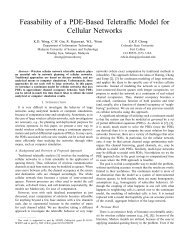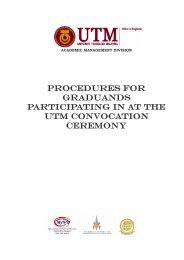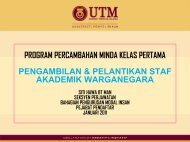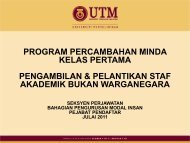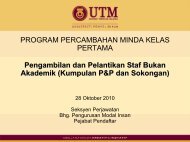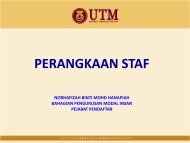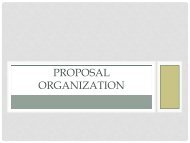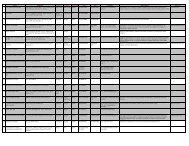PAN ASIA ICT R&D Grants Programme - UTM
PAN ASIA ICT R&D Grants Programme - UTM
PAN ASIA ICT R&D Grants Programme - UTM
- TAGS
- grants
- programme
- web.utm.my
You also want an ePaper? Increase the reach of your titles
YUMPU automatically turns print PDFs into web optimized ePapers that Google loves.
In the next phase, the project team<br />
developed a physical model for Nafees<br />
Nasta’leeq. The model covered the<br />
work done at the True Type Font (TTF)<br />
level and the efforts at the OTF level.<br />
During this phase, the team listed and<br />
finalized the individual glyphs, which<br />
form building blocks of the font. The<br />
team then defined procedures needed<br />
to convert these glyphs from images to<br />
splines (standard mathematical form<br />
for glyph outline). Similarly the team<br />
also decided what work needed to be<br />
Vectorization of the letters<br />
done at the True Type (which is the<br />
earlier font specifications) level.<br />
Finally, the team indicated the contextual<br />
rules for substitution and positioning.<br />
The implementation phase can be<br />
broadly divided into three sub phases:<br />
1) image processing: acquisition of<br />
Nasta’leeq glyphs and ligatures,<br />
scanning of Nasta’leeq glyphs, segment<br />
joint verification and ligature shape<br />
refinement, thresholding of Nasta’leeq<br />
glyphs (monochrome), and<br />
vectorization of Nasta’leeq glyph<br />
outlines; 2) TrueType Level Work:<br />
glyph size for Nasta’leeq font, positioning<br />
of glyphs at the TTF level,<br />
joining of glyphs at the TTF level,<br />
including missed shapes, glyph<br />
ordering, and TTF file organization;<br />
and 3) OpenType Level Work: Unicode<br />
assignment, glyph grouping, implementing<br />
substitution, positioning,<br />
cursive positioning, mark positioning,<br />
and kerning rules.<br />
The project team tested the font at<br />
three levels before releasing it. Firstly,<br />
Nafees Nastalique<br />
all valid ligatures of Urdu were tested.<br />
Secondly, written texts of Urdu from<br />
various fields were tested. Thirdly, 1.7<br />
M words were taken from frequency<br />
analysis of Urdu done by the Center<br />
for Research in Urdu Language<br />
Processing (CRULP) and tested. The<br />
font is now freely available at<br />
www.crulp.org.<br />
The researchers contributed by<br />
organizing free font training sessions<br />
at font seminars to provide an insight<br />
into font making. In addition, the<br />
grant has helped in acquiring<br />
new equipment such as a<br />
printer, personal computers<br />
and a scanner. The team was<br />
also able to purchase specialized<br />
software required for<br />
font development. Thus, the<br />
research team can utilize the<br />
software obtained and the<br />
experience gained through<br />
this project to work more on<br />
other computationally<br />
unexplored scripts. Also this<br />
grant strengthened CRULP<br />
capacity for analysis and<br />
research. Through this grant,<br />
CRULPmatured into a growing center<br />
of excellence in the computation of<br />
Urdu and other regional languages.<br />
The experience that the research<br />
team has made it easier to anticipate<br />
and identify problems in the analysis<br />
A calligraphy session<br />
phase and to take remedial measures<br />
before prospective problems occurred.<br />
As an example, OTF technology was<br />
thoroughly tested through prototyping<br />
the Nafees Naskh font. This exercise<br />
also served the dual purpose of training<br />
the student team in the technical details<br />
of the new font formalism. This proved<br />
to be a useful exercise for the actual<br />
design and development of the Nafees<br />
Nasta’leeq font and saved a lot of time.<br />
The project was managed in<br />
separate planning, analysis, design,<br />
implementation and testing cycles,<br />
following conventional software<br />
engineering practices. Extensive testing<br />
was done to identify three levels of<br />
bugs. All level-one bugs were removed.<br />
Though other level bugs were<br />
also removed, some level-two and<br />
some level-three bugs were left open<br />
because the team ran out of space<br />
within the OTF formalism to write any<br />
further rules. The Beta version of font<br />
was released on the 14th of August 2003<br />
and is currently being maintained to<br />
remove any additional bugs reported<br />
by end users.<br />
Lasting Impacts<br />
Nafees Nasta’leeq is a successful<br />
project. The results can be attributed to<br />
the hard work of the core team (the<br />
funded students at CRULP) who spent<br />
30



